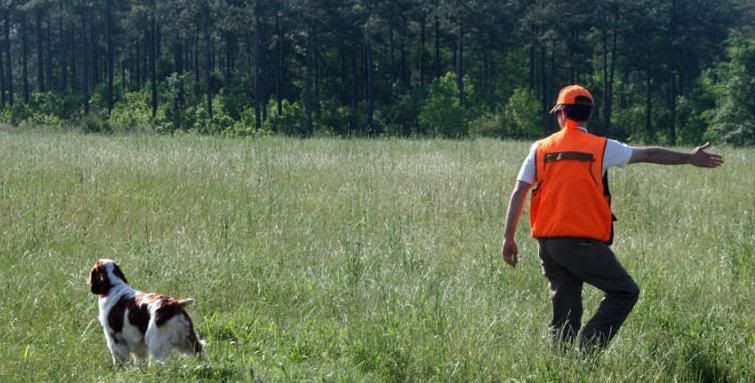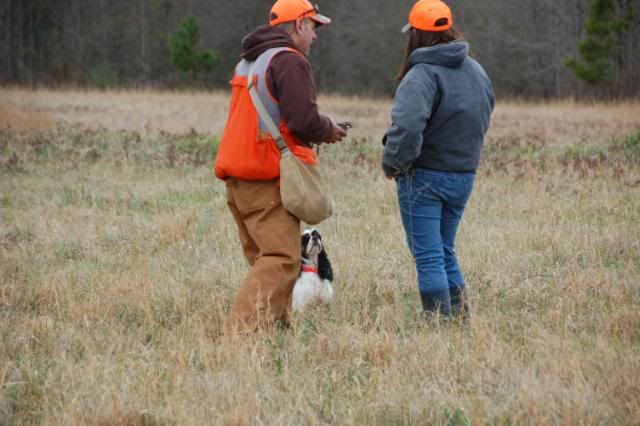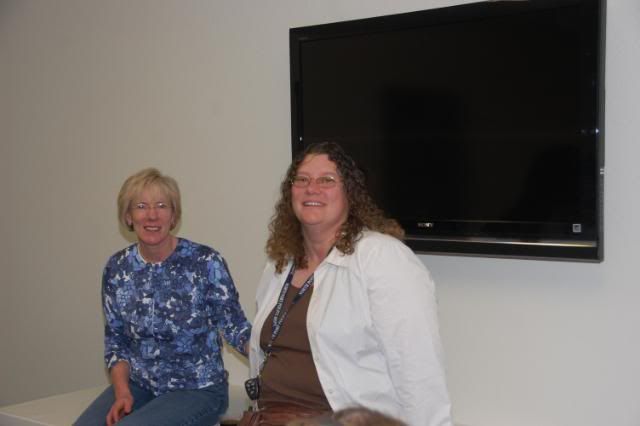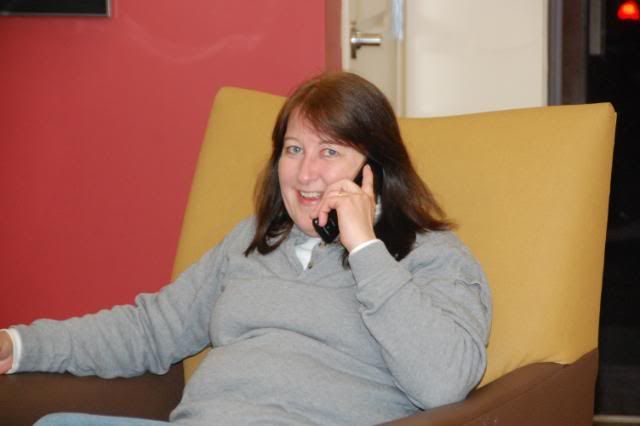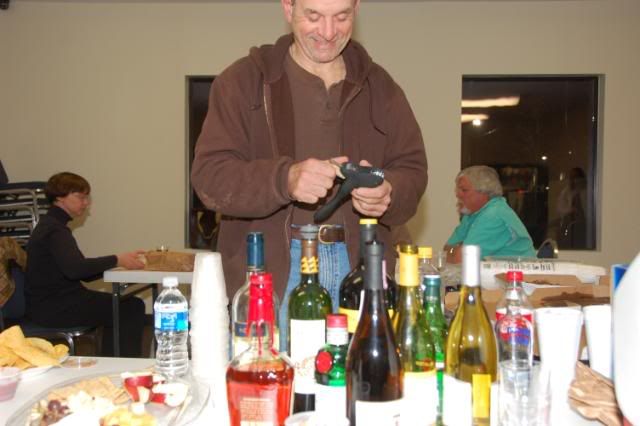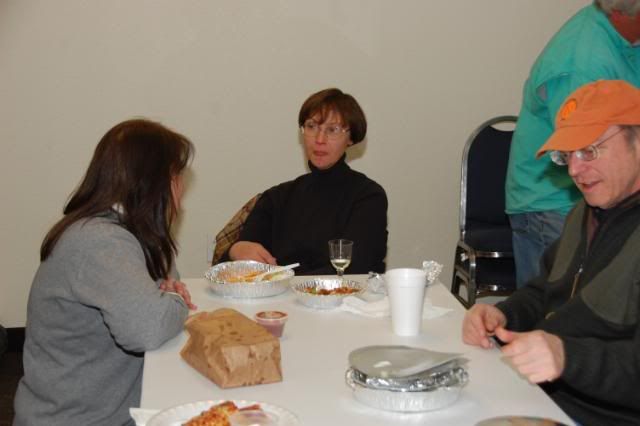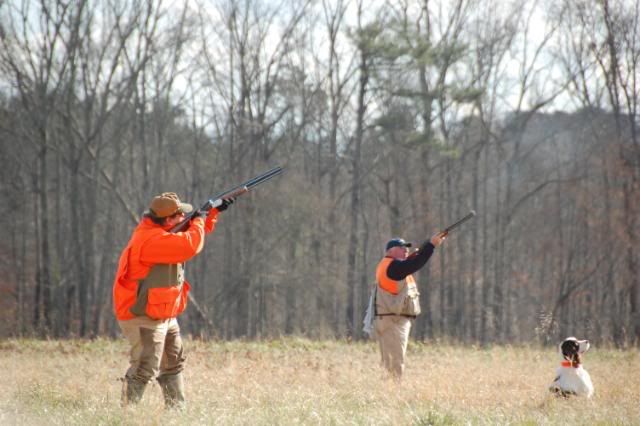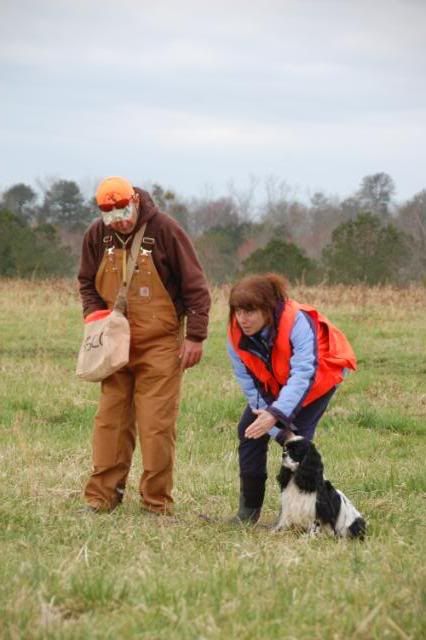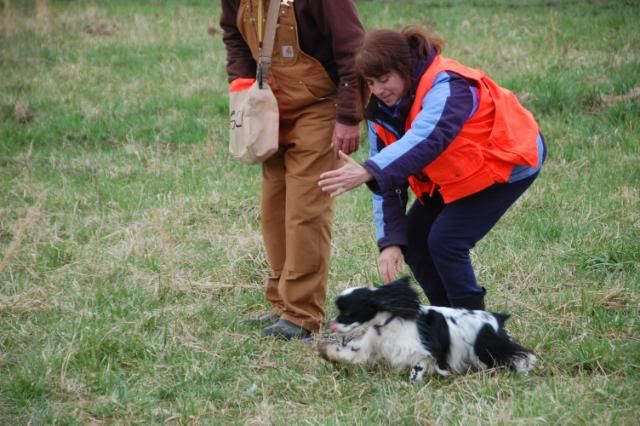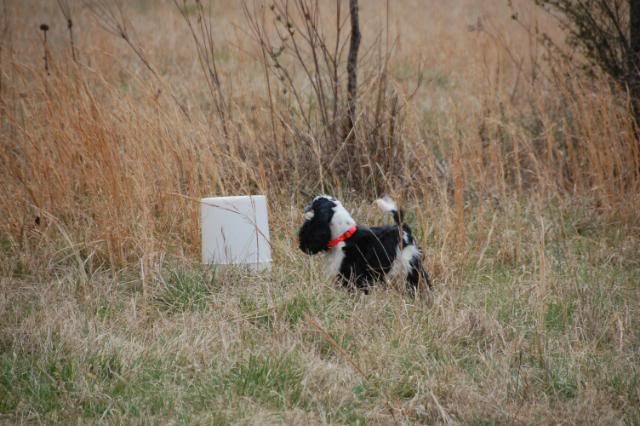In the shameless self-promotion division, we asked -- ok, we begged -- Meghen at Statesman WSS to mention our blog on her website. Thanks, Meghen. (click to enlarge)
You can find Meghen's website linked on the right "Statesman Welsh Springer Spaniels".
Wednesday, March 31, 2010
Tuesday, March 30, 2010
The pick-up drill
You've got a dog with a good nose and beautiful quartering. There's one small problem: he doesn't want to bring the bird to you. He wants to go on parade. Flip the bird on the end of his nose. Show the admiring gallery what a wonderful and resourceful creature he is. And you, dear handler, are to stand to one side like the man who holds James Brown's cape (at the 1:00 and 2:00 minute marks). What can we do about this?
Joe suggested the pick-up drill. The pick-up drill is nothing more than shake-a-bird (see Shake-a-bird 3/22/10) with a twist .
Line up in shake-a-bird formation. Face your dog. Maybe take another step back to get some separation. Don't loom. Relax. Wait.
Now, start him off (see How to begin 3/22/10). Let him take those three or so turns. Here's the twist. Unknown to your dog, you hold a dead bird. Just after the dog passes you on a quarter (and please remember to stand completely still any time the dog crosses in front of you) and heads toward the gunner who is shaking his bird, you roll your bird a few feet or yards in front of you. On his way back, puppy will scent the bird and will pounce on it. The moment he grabs it, call him gently: "Here boy!" (you are only a few feet away) Pat your thigh. Welcome him home.
The thought here is that he is so close to you, that, come? Why, sure! There you are! And here is the bird for you! He delivers the bird before he realizes what he has just done. Maybe take a step back. Kneel to receive the bird. Gently done. Thank you dear heart. thank you, good boy.
Joe suggested the pick-up drill. The pick-up drill is nothing more than shake-a-bird (see Shake-a-bird 3/22/10) with a twist .
Line up in shake-a-bird formation. Face your dog. Maybe take another step back to get some separation. Don't loom. Relax. Wait.
Now, start him off (see How to begin 3/22/10). Let him take those three or so turns. Here's the twist. Unknown to your dog, you hold a dead bird. Just after the dog passes you on a quarter (and please remember to stand completely still any time the dog crosses in front of you) and heads toward the gunner who is shaking his bird, you roll your bird a few feet or yards in front of you. On his way back, puppy will scent the bird and will pounce on it. The moment he grabs it, call him gently: "Here boy!" (you are only a few feet away) Pat your thigh. Welcome him home.
The thought here is that he is so close to you, that, come? Why, sure! There you are! And here is the bird for you! He delivers the bird before he realizes what he has just done. Maybe take a step back. Kneel to receive the bird. Gently done. Thank you dear heart. thank you, good boy.
Monday, March 29, 2010
If you want me, just whistle
The Acme 210 1/2 Spaniel whistle.
(Listen to the Acme 210 1/2 Spaniel whistle)
The Acme 210 1/2 is the standard whistle for spaniels in the field. It is pealess and offers a peep that is less offensive than the typical gym whistle. Using a whistle rather than your voice can help keep the birds from realizing that the game is afoot. Over time, bird dog handlers have developed a language using the whistle.
Stop, sit, stay...........................1 long pip.
Turn direction on quartering..........2 short pips.
Come in..................................4 short pips.
Sunday, March 28, 2010
On our way home
Larsen and I tried out my new BackTrack yesterday at Lake Alatoona. I'd gotten the BackTrack with some Amazon credit card points, along with Joe Irving's nicely written book, "Training Spaniels."
The BackTrack is a little bigger than I thought it would be.
It was easy to set.
It allowed us to have some adventures off the beaten track.
And see a Cooper's hawk
But we knew we could find our way home.
We made it all the way around the pond!
The BackTrack is a little bigger than I thought it would be.
It was easy to set.
It allowed us to have some adventures off the beaten track.
And see a Cooper's hawk
But we knew we could find our way home.
We made it all the way around the pond!
Saturday, March 27, 2010
Your day can begin in the parking lot
Larsen inspects a confused chukar.
You might not want to take a shot at this errant chukar, but it illustrates that your dog's thoughts, and yours as well, should tune into the hunt as soon as you arrive.
Friday, March 26, 2010
Bird down!
Your dog has flushed the bird and you or your partner has shot it. It has gone down somewhere along the tree line. Some of Joe's thoughts:
- No noise when the dog is near the fall.
- On difficult marks, ask the judge if you can move up.
- If the dog can't find the bird, don't panic. Bring the dog in or close to you. Stop. Count to 10. Move yourself so that you, puppy, and bird are in a line. Give the dog the "back" command.
- On the dog's retrieve: watch your posture. The bird is a gift from your dog. Don't snatch it. Don't hoover over the dog.
- Soothing praise for your dog. Stroke him, don't pet him or tossle his ears unnecessarily.
Thursday, March 25, 2010
It's your turn
Joe provided some good thoughts about how to proceed when it is your turn.
Trust your dog.
"Who do you believe, me or that big nose of yours?"
Tomorrow: What to do when the game is down.
- Know where you are with your training. Don't expect more or less from the dog than you get in practice.
- Don't loom over your dog. It makes him nervous. Move back.
- If puppy's attention is wandering, shuffle a few more steps back. That will get his attention.
- Control the dog from the first moment. Give puppy every opportunity to use the grounds to his advantage.
- Be patient when you let the dog go. Let the dog find himself. It's not unusual for a dog to take a big bite on the first cast. Don't freak. Help him in. All the same, it would be nice to have that first, downwind cast be pretty flat along the line.
- Calm down. Avoid nervous tones in your voice. Cut the chatter and unnecessary commands. Don't play a tune on your whistle.
- If possible, stop the dog at least once as he passes in front of you. Maybe after the 2nd pass. This maintains a sense of control and purpose.
- Be a teammate. Hunt with your dog. Be involved in the hunt. Don't just be an idle observer.
- Trust your dog. If you see a bird, guide the dog to it, but don't overdo. First of all, some judges don't like it, and second, if the dog is off somewhere else, maybe he has a bead on something, too. Finally, if you are calling him over and he isn't interested, your grade goes down.
- Study and understand your dog's posture when he finds game ("gets birdy"). But don't just stand there or freeze. Get as close as you can without interfering.
- Move to the dog when he is getting birdy and making game. Don't freeze in place. You'd hustle up to the dog if you were rough hunting, right? You may want to tell the judge what you are doing.
- When the bird is in the air STOP moving.
Trust your dog.
"Who do you believe, me or that big nose of yours?"
Tomorrow: What to do when the game is down.
Wednesday, March 24, 2010
Before you begin
Rain or shine, hunting in an open field or a brambly and marshy covert with your dog is one of life's unheralded pleasures.
Hunting Tests are not the same as being afield with your dog but they are wonderful places for you and your dog to learn, to show off what you have learned, and to meet like-minded people who love their dogs and the hunt.
Joe asked us to think about how we approach the Hunting Test from the moment we pull into the parking lot. With a little modification, these rules apply to rough hunting as well.
Watching and learning.
Tomorrow: Some rules for when you get to the line.
Hunting Tests are not the same as being afield with your dog but they are wonderful places for you and your dog to learn, to show off what you have learned, and to meet like-minded people who love their dogs and the hunt.
Joe asked us to think about how we approach the Hunting Test from the moment we pull into the parking lot. With a little modification, these rules apply to rough hunting as well.
- Don't be late. Come early. Air out your dog. Get a feel for the grounds.
- Relax. This is a good day. You and your little dog. Afield. Hunting.
- Observe. Hang out with the gallery following behind the judges. Pay attention. Follow along. If you're slated to start late, shag the dead birds. Listen to what the judges are saying, if you can.
- Don't keep puppy cooped up. Let him see, hear, and smell what's going on. Let him get with the flow so he isn't super-excited or half asleep when it's finally his turn. Have some fun with him. Of course, don't interfere with anyone or his or her dog.
Watching and learning.
Tomorrow: Some rules for when you get to the line.
Tuesday, March 23, 2010
Archer @ 2
Archer is Larsen's 1/2 brother (Felix x CH Idlewild's Mazie Morning Dew JH SH (Mazie)). Aki and I stopped by Randy and Jamie's house to have fun with the dogs. MaryAnne brought Chance, and friend Marilyn & Larry brought the sweet little ESS, Malley. It was a great little party on a cool, rainy Sunday afternoon.
Archer is 2 years. He's still sporting the Lion King look that he picked up at camp.
Malley is a delightful little English.
It was a spaniel extraveganza. WSS, ESS, and ACS.
Chance (L) and Archer (R) went nose to nose with the pull-toy.
Archer is 2 years. He's still sporting the Lion King look that he picked up at camp.
Malley is a delightful little English.
It was a spaniel extraveganza. WSS, ESS, and ACS.
Chance (L) and Archer (R) went nose to nose with the pull-toy.
Monday, March 22, 2010
How to begin
Most game birds - - partridge, quail, chukar, and pheasants (even turkey and chicken) - - are gallinaceous. Most galliforms are weak flyers and prefer to scoot along the ground or even burrow into the grass. The spaniel roots them out and gives them cause to take flight, where they can be shot. You want your dog to cover the ground thoroughly, and not overlook any birds, but quickly and without dawdling over barren ground.
The shake-a-bird exercise is used to teach quartering (zig-zagging in front of you and over the field). But first you need to know how to begin.
Stand in the middle of a line that reaches from the left- to right-hand gunner. The gunners face the field. On a football field layout, the gunners are on the sidelines like split ends, facing toward the goal line. You and doggie are in the middle, the quarterback's position, but facing your own goal line.
Hup your dog and take a second to calm everyone. Now take two steps or so from the dog, turn, and face him. You are now in the quarterback position. Your dog is in the center position, but facing you. You are ready to begin. But it's up to you. So wait a second or more. Maybe take one more step back to get some separation between you and your dog. Let's get everything under control.
Whisper is hupped and faces Venee. Joe gives some tips to the team.
This next step is complex. Call your dog ("here boy!" and pat your thigh) and let the dog take a step or two toward you, then cast the dog right or left away from the wind. Tell your dog "get on." That is his oral cue to start hunting. Use your right hand if you are casting to the left, and your left hand if you are casting to the right. Let the dog get moving along the line. Then pip him to turn into the wind. Now you are off.
Here's the thinking on this sequence. By initially calling your dog toward you and then casting him off you are exerting a little additional control over the dog. Covering the field is not chaos. It is controlled. You and your dog work as a team. Beginning the run in the field by calling the dog toward you impresses upon doggie that you are in control.
Dogs prefer to work into the wind. They get a full measure of scent from the breeze that way. Casting off away from the wind is a bit unnatural, and that is the point. The dog is not as eager to go downwind. The scent is the other way! Now, you don't have to let him go very far before you pip him and turn him into the wind. Just a bit so that he does not start out as a wild animal. You are in control. When he turns upwind, he will have to cross your path and therefore engage you. Another point of control.
Oh, and stand still any time your dog crosses in front of you. Don't move your feet, don't move forward. Don't confuse your dog. Stand still.
The shake-a-bird exercise is used to teach quartering (zig-zagging in front of you and over the field). But first you need to know how to begin.
Stand in the middle of a line that reaches from the left- to right-hand gunner. The gunners face the field. On a football field layout, the gunners are on the sidelines like split ends, facing toward the goal line. You and doggie are in the middle, the quarterback's position, but facing your own goal line.
Hup your dog and take a second to calm everyone. Now take two steps or so from the dog, turn, and face him. You are now in the quarterback position. Your dog is in the center position, but facing you. You are ready to begin. But it's up to you. So wait a second or more. Maybe take one more step back to get some separation between you and your dog. Let's get everything under control.
Whisper is hupped and faces Venee. Joe gives some tips to the team.
This next step is complex. Call your dog ("here boy!" and pat your thigh) and let the dog take a step or two toward you, then cast the dog right or left away from the wind. Tell your dog "get on." That is his oral cue to start hunting. Use your right hand if you are casting to the left, and your left hand if you are casting to the right. Let the dog get moving along the line. Then pip him to turn into the wind. Now you are off.
Here's the thinking on this sequence. By initially calling your dog toward you and then casting him off you are exerting a little additional control over the dog. Covering the field is not chaos. It is controlled. You and your dog work as a team. Beginning the run in the field by calling the dog toward you impresses upon doggie that you are in control.
Dogs prefer to work into the wind. They get a full measure of scent from the breeze that way. Casting off away from the wind is a bit unnatural, and that is the point. The dog is not as eager to go downwind. The scent is the other way! Now, you don't have to let him go very far before you pip him and turn him into the wind. Just a bit so that he does not start out as a wild animal. You are in control. When he turns upwind, he will have to cross your path and therefore engage you. Another point of control.
Oh, and stand still any time your dog crosses in front of you. Don't move your feet, don't move forward. Don't confuse your dog. Stand still.
Shake-a-bird
Shake-a-bird is a drill that teaches a young spaniel to quarter . It can teach a more experienced dog to retrieve. In fact, it has several important uses. Here's how shake-a-bird works.
Hup your dog on the centerline between the two gunners. Neither gunner has a gun for this drill. Instead, each has a dead bird.
Turn and face your dog. Start him as described earlier. Call him in for a few steps and then start him in the same direction as the wind (assuming left-to-right or right-to-left wind or, better, a wind from the front left or right quarter). Let him move out a few steps, maybe half way to the downwind gunner, then reverse him into the wind. To turn the dog, you pip your whistle (twice) and point your open hand in the direction that you want the dog to go. You use your left hand to point to the right and your right hand to point to the left. This forces you to turn your body and move in the direction you want the dog to go and gives him the full visual cue of your instruction.
At the moment of the turn, the upwind gunner holds out his bird and shakes it. He makes birdie sounds to attract the dog's attention.
As the dog gets close to the gunner and his bird, you pip your whistle (twice) to turn the dog. As before, you use your left hand to point to the right gunner and your right hand points to the left gunner. Turn your body in the direction that you want the dog to go.
At the moment of the pipping, the upwind gunner pretends to toss the dead bird forward with an underhand motion. This fakes out the dog who will turn up field to find the bird. The gunner quickly brings the bird behind his back and quits making any birdie sounds. The dog may be at a temporary loss as to where the bird went, but he will quickly pick up on your posture and on the birdie sounds that the opposite gunner now is making. This will re-orient puppy and restart the chase in the other direction. He's quartering!
Back and forth we go. For a young dog, you may have to walk very much toward each gunner to help the dog understand the quartering move. For a more experienced dog, stay in the center and motion him one way or the other by turning your body.
Complete 3-5 crosses. Keep the exercise short and fun.
The dog should get the bird at the end. For a young dog, one gunner or the other tosses the bird out as the dog closes in. Success!
Bill shakes the pigeon and peeps like a chukar.
Bill sells the bird to a reluctant clumber.
The fake toss turns the dog upfield. Venee turns toward the opposite gunner and points the way.
Off she goes!
Tim does not use his opposite hand to signal, but the experienced Rags knows this drill.
Hup your dog on the centerline between the two gunners. Neither gunner has a gun for this drill. Instead, each has a dead bird.
Turn and face your dog. Start him as described earlier. Call him in for a few steps and then start him in the same direction as the wind (assuming left-to-right or right-to-left wind or, better, a wind from the front left or right quarter). Let him move out a few steps, maybe half way to the downwind gunner, then reverse him into the wind. To turn the dog, you pip your whistle (twice) and point your open hand in the direction that you want the dog to go. You use your left hand to point to the right and your right hand to point to the left. This forces you to turn your body and move in the direction you want the dog to go and gives him the full visual cue of your instruction.
At the moment of the turn, the upwind gunner holds out his bird and shakes it. He makes birdie sounds to attract the dog's attention.
As the dog gets close to the gunner and his bird, you pip your whistle (twice) to turn the dog. As before, you use your left hand to point to the right gunner and your right hand points to the left gunner. Turn your body in the direction that you want the dog to go.
At the moment of the pipping, the upwind gunner pretends to toss the dead bird forward with an underhand motion. This fakes out the dog who will turn up field to find the bird. The gunner quickly brings the bird behind his back and quits making any birdie sounds. The dog may be at a temporary loss as to where the bird went, but he will quickly pick up on your posture and on the birdie sounds that the opposite gunner now is making. This will re-orient puppy and restart the chase in the other direction. He's quartering!
Back and forth we go. For a young dog, you may have to walk very much toward each gunner to help the dog understand the quartering move. For a more experienced dog, stay in the center and motion him one way or the other by turning your body.
Complete 3-5 crosses. Keep the exercise short and fun.
The dog should get the bird at the end. For a young dog, one gunner or the other tosses the bird out as the dog closes in. Success!
Bill shakes the pigeon and peeps like a chukar.
Bill sells the bird to a reluctant clumber.
The fake toss turns the dog upfield. Venee turns toward the opposite gunner and points the way.
Off she goes!
Tim does not use his opposite hand to signal, but the experienced Rags knows this drill.
Saturday, March 20, 2010
At day's end
It's not all work on a training weekend. We had plenty of time for some cocktails and camaraderie. Aki drove down from Atlanta with some cheese & crackers, which tided us over until the pizza came.
Aki and Mary trade stories about their mischievous Welsh Springer Spaniels.
Venee reports in to sister Vickie in Wisconsin.
Joe picks his poison.
Clumber talk in this corner.
Cathy, MJ, Venee, and Joe engage in a roundtable covering the day's training events.
Aki and Mary trade stories about their mischievous Welsh Springer Spaniels.
Venee reports in to sister Vickie in Wisconsin.
Joe picks his poison.
Clumber talk in this corner.
Cathy, MJ, Venee, and Joe engage in a roundtable covering the day's training events.
Friday, March 19, 2010
Here!
You called your dog. She runs off. You quietly walk after her. Step by step. Until she gives in. March her back to the scene of the crime by lifting her front legs from the ground. When you get back, hup her. Step back a few feet. Here girl! Hup. Step back again. Here girl! Hup. Good girl.
Ow, ow, ow.
Ow, ow, ow.
Thursday, March 18, 2010
Steady to shot
Rags waits for the "fetch" command.
After flushing the bird, the dog should sit, or hup. This is for his safety and so that he can mark the fall of the bird. Here's what it looks like. Good boy, Rags!
Wednesday, March 17, 2010
Hunt dead
You've shot the bird and it drops somewhere along the tree line. You marked it and now you prepare to send your dog to get the bird. This is the hunt dead.
To teach a dog hunt dead, set a 5-gallon bucket (or a traffic cone or other evident marker) 30 yards from your line. Set the bucket at the edge of the field just into the tall grass for a new dog. Move it deeper into the tall grass for a more experienced dog. Don't make it too challenging. You want a successful happy dog.
Stand about 10 yards away from the bucket with your hupped dog. Your colleague will drop a dead bird straight down behind the bucket (or maybe in front of the bucket to make it easier). As the bird falls, you calmly say "dead".
Turn and silently walk with your dog back to the 30 yard mark. Let him think. Turn and face the bucket. Hup your dog. Line him up. Make your left hand like a tomahawk or blade in front of his nose so that bringing your hand up and forward will form a line from his nose to the bucket. Hold. Calmly move your right foot back a yard or two. Hold.
Now step forward with your right foot and at the same instant bring your left hand forward toward the bucket while you say your dog's name (his signal to break). Your movement and call will be the only signal he needs to take off after the downed bird.
If he loses his way, you can handle him with pips and hand signals. If he starts to return to you, or somehow does not go to the bucket, you have a chance to teach him "back". Walk toward him while saying "back, back" and pushing or waving your outstretched palm toward him. You can stop walking and talking when he gets the idea. You cannot walk toward your dog like this during a hunt test, but this is training.
Once the dog picks up the bird, pip him in. Pat your thigh. Accept the gift. Good boy. Good girl.
Step 1: From about 10 yards. "Dead."
Step 2: The lineup. Back at the 30 yard mark. Left hand like a blade. Getting ready to calmly step the right foot back.
Step 3: The release. "Puppy!" Left hand goes up and toward the bucket. Step forward with the right foot.
It smells birdy out here.
I found it!
To teach a dog hunt dead, set a 5-gallon bucket (or a traffic cone or other evident marker) 30 yards from your line. Set the bucket at the edge of the field just into the tall grass for a new dog. Move it deeper into the tall grass for a more experienced dog. Don't make it too challenging. You want a successful happy dog.
Stand about 10 yards away from the bucket with your hupped dog. Your colleague will drop a dead bird straight down behind the bucket (or maybe in front of the bucket to make it easier). As the bird falls, you calmly say "dead".
Turn and silently walk with your dog back to the 30 yard mark. Let him think. Turn and face the bucket. Hup your dog. Line him up. Make your left hand like a tomahawk or blade in front of his nose so that bringing your hand up and forward will form a line from his nose to the bucket. Hold. Calmly move your right foot back a yard or two. Hold.
Now step forward with your right foot and at the same instant bring your left hand forward toward the bucket while you say your dog's name (his signal to break). Your movement and call will be the only signal he needs to take off after the downed bird.
If he loses his way, you can handle him with pips and hand signals. If he starts to return to you, or somehow does not go to the bucket, you have a chance to teach him "back". Walk toward him while saying "back, back" and pushing or waving your outstretched palm toward him. You can stop walking and talking when he gets the idea. You cannot walk toward your dog like this during a hunt test, but this is training.
Once the dog picks up the bird, pip him in. Pat your thigh. Accept the gift. Good boy. Good girl.
Step 1: From about 10 yards. "Dead."
Step 2: The lineup. Back at the 30 yard mark. Left hand like a blade. Getting ready to calmly step the right foot back.
Step 3: The release. "Puppy!" Left hand goes up and toward the bucket. Step forward with the right foot.
It smells birdy out here.
I found it!
Tuesday, March 16, 2010
The gift
The dog's retrieve is a gift to you. He found the bird. He wants the bird. Instead, he brings the bird to you. You accept it as a grateful teammate. Thank the dog in soothing tones. No need for big praise. The dog already is amped and doesn't need to be charged up more. He just flushed the game. He tracked it down after its fall. He corralled the bird, maybe fought it, picked it up and has just run back to you with it. Settle him. Let him collect himself. Get organized. Settled. Get ready to begin again. Thank him. Good boy. Good girl.
Here girl!
Thank you.
Here girl!
Thank you.
Monday, March 15, 2010
A big dog with a soft mouth
Rags returns with a gift this weekend at hunt test training.
A weekend with a passel of spaniels never unfolds the way you might expect, whatever your expectations are. The weekend at Luke Weaver's farm, training dogs, was as enjoyable a time as anyone could have had on a blustery, rainy March weekend. The forsythia and cherry were blooming but it still felt like late January or February and the field was nothing but mud, to the sheer delight of the dogs.
The dogs behaved well, they behaved badly. The dogs came in on the run, and they broke all over the field. In the end, all of the handlers believed that they saw something positive and got some new training ideas. Rags, Tim's English working on his Master level hunting title (and the shown in the illustration), set the standard for all of the dogs.
We learned that the game, the bird, is a gift from the dog. You do not take a bird from the dog. You gratefully accept the gift presented to you. You calmly and lovingly thank the dog for such a gift.
Larsen was voted "Most Improved Dog," but not really due to any improvement so much as the Sunday contrast with his odd and subdued performance on Saturday. He was totally lacking in drive on Saturday. It may be as simple as him not responding to pigeon. He responded with enthusiasm to the quail on Sunday.
Joe the instructor and Venee, an accomplished handler, gave Larsen a nice compliment, describing him as having a "a soft mouth for such a big dog." Larsen retrieved twice in a row, and alive, the same peeping, delicate, little bobwhite. Venee said that most dogs would chomp the bobwhite since they sqeak, they are soft, and they are very easy to kill. Larsen is a big lunk and he handled the bird with TLC, even after toying and playing with it.
Larsen is his own dog and marches to his own beat. Right now, he's a jigsaw puzzle with big islands of completed picture that don't yet connect. It might just take a few small pieces to make the whole thing hang together. Our approach, based on what we learned, is to keep everything elemental. Pull the exercises apart and work on one thing at a time. We will work with his islands of understanding and good performance and gradually extend them until he finds the connecting pieces.
Sunday, March 14, 2010
CH Stufield's March Morning (a/k/a Larsen)
Today, Larsen is a 3-year old dog. He's no longer a puppy. He is a 54 lb Welsh Springer Spaniel that feels like slab of beef when you give him a friendly swat.
Stufield's "March" litter at about a week (3/2007).
Larsen (right), with Mazie and littemate, getting more than his fair share.
We like Asterix.
Larsen. (7/2009)
Stufield's "March" litter at about a week (3/2007).
Larsen (right), with Mazie and littemate, getting more than his fair share.
We like Asterix.
Larsen. (7/2009)
Saturday, March 13, 2010
Luke Weaver's farm
Larsen gets a kiss and a cookie.
Larsen and I are at Luke Weaver's farm attending Judge Joe's flushing spaniel seminar. We'll report in on Monday. We'll also report in on little Chance's progress in Novice 2 - - ah, 1.
Sunday is Larsen's birthday, and we'll post up some long-ago puppy photos of WCP, World's Cutest Puppy.
World's Cutest Puppy.
Friday, March 12, 2010
Pedigree Engine tells all

You might be interested in Larsen's pedigree, or that of any other Welsh Springer Spaniel. The link below takes you to the WSS Pedigree Engine, which is a database of ancestors and progeny. It's essentially an electronic family tree for many of the Welshies around the world. It's used not only for fun, but also for breeding and health evaluation purposes.
To see Larsen's entry, type "ch stufield's march morning" (his AKC name) into the Pedigree Engine's name box. It works with "Larsen" as well.
http://www.pedigree-engine.com/wss/ped.cgi?search
Thursday, March 11, 2010
More rain, mud, and spring
Larsen surveys the muddy yard.
Those fancy French rubber boots will get broken in this weekend if this weather holds. It started raining yesterday, hard. Impressive thunder. The lightening hidden in the clouds, though. Afterward, the robins were wheeling and squealing their "cheerios". This morning is a constant drizzle and the yard is a muddy mess. The cherrys are beginning to blossom but that is the only real sign of the turn. That and the robins, of course. We'll practice "holds", "take it", "drop it" today in the hallway.
Those fancy French rubber boots will get broken in this weekend if this weather holds. It started raining yesterday, hard. Impressive thunder. The lightening hidden in the clouds, though. Afterward, the robins were wheeling and squealing their "cheerios". This morning is a constant drizzle and the yard is a muddy mess. The cherrys are beginning to blossom but that is the only real sign of the turn. That and the robins, of course. We'll practice "holds", "take it", "drop it" today in the hallway.
Tuesday, March 9, 2010
Chuck Norris jokes
When an episode of Walker Texas Ranger aired in France the French immediately surrendered to be on the safe side.
Chuck Norris can kill two stones with one bird.
Chuck is the only person on the planet that can kick you in the back of the face.
There are no such things as tornados. Chuck Norris just hates trailer parks.
The Black Eyed Peas were just The Peas until Chuck Norris heard their music.
When Chuck Norris jumps in a lake he doesn't get wet, the lake gets Chuck.
Chuck Norris doesn't sleep. He waits.
Guns don't kill people. Chuck Norris kills people.
Chuck Norris doesn't read books. He stares them down until he gets the information he wants.
Chuck Norris had a paper route when he was a child. There were no survivors.
Chuck Norris sleeps with a pillow under his gun.
Last year Chuck Norris went to the Kentucky Derby.......and won.
Chuck Norris does not know about this thread. If he did he would just delete the internet.
Subscribe to:
Posts (Atom)











